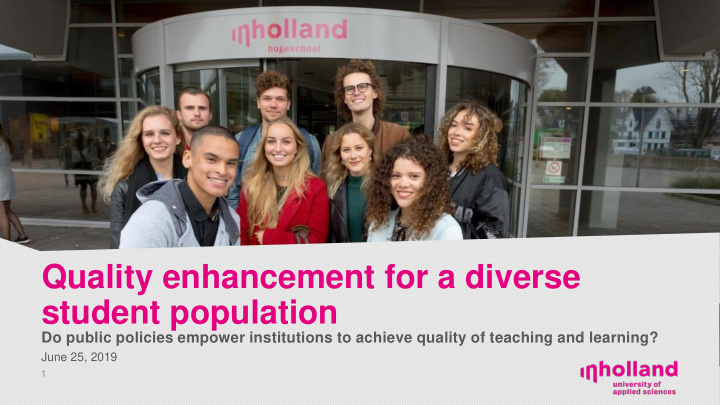



Quality enhancement for a diverse student population Do public policies empower institutions to achieve quality of teaching and learning? June 25, 2019 1
Quality enhancement for a diverse student population Do public policies empower institutions to achieve quality of teaching and learning? June 25, 2019 2
• Alkmaar Haarlem Amsterdam | Diemen The Hague Delft Rotterdam 25,000 students 2,200 employees Dordrecht Personal approach Sustainable, healthy, creative Ass, Ba & Ma degrees
My resumé 4
Agenda How does that work out for Inholland? Institional policy Focus on National policy diversity 4 Perspectives Conclusion
National policy for higher education 1. Strategic Agenda 2. Budget • Quality: throughput, output, satisfaction • Criteria → Drop out rates after year 1 → Number of students → # Degrees of 1st entry after 5 years (C+1) → Maximum of 4 years budget per student → National Student Survey → Premium for degrees issued • Intake of students: more from vocational → Varying rates for specific types of studies (technical, arts, etc) education; study advice 3. Quality Agreements 3% - 7% budget • Portfolio: Associate Degree, Bachelor, Master programmes • Separate agreement for quality improvement in education • Research → Checked by NVAO • 2019: new agenda to be made 6
Change in focus from efficiency to impact and inclusivity 7
How that works out for Inholland: institutional policy Professional Activating products education Supported by Learning technology communities 8
Important focus point: diversity 9
Why? What? • Education • Inholland is a mirror of society → Many students of non-western descent • Research → Women on top? → Students with disabilities → Also: sexuality, beliefs, upbringing, • Personnel policy economic status, musical preference, love of arts, competencies, passions, etc. etc. • Safety policy • More diverse teams perform better → But: only in an inclusive environment • War on talent → Requires we don’t waste our talent
Bias or not? • Question: “ how does one keep the quality at a high level, if there are a lot of students of non- western descent ?” → Is non-western descent a quality issue? • Data show: the odds are not in their favour, but is that for lack of learning ability? • What is the problem? → Bad performance? → Language? → Lack of inclusivity, or even discrimination? → Economic background (lack of resources)? → Belief system? 11
Inclusive education will not arrive of its own accord • Universities are mini societies. → Tensions in society are not outside but inside. There are real obstacles due to gender, sexuality, faith, ethnicity, age, handicaps, money, etc.. There are serious tensions, in particular around ethnicity, that we deal with. • Teacher can promote inclusivity (or damage it). → Ensure safety in the classroom. Practical exercises and interventions. → A diverse perspective (disagreement) will lead to better analysis and better solutions. Takes leadership and safety to make it explicit and productive. → Remember, as a human being we are defined by more than one aspect. Our similarities are greater than our differences. • This belongs in educational vision and education design. 12
Diversity requires attention in your field of expertise • Could there be bias in your field? Or, how does diversity show itself in your field? → Examples: the woman’s heart; origin of life; the research interviewer’s background in relation to answers given → What research should be on the agenda, because it needs investigating? • What should alumni know and do to be a successful practitioner in a superdiverse society? → For example as a nurse, market researcher, accountant, policy advisor? → Integrate that into what you teach and research! Contribute to the improvement of your field. 13
Personnel Policy Safety Policy • Charter Diversity (Diversiteit in • Inclusivity and a safe space for Bedrijf/SER) everyone is leading → Signed and approved by university → Freedom of speech for all council → Boundaries need to be monitored and • Positive action? made explicit • Strong role for preventive action → Yes, depending on assessment of the current diversity and identified gaps → Course for key figures: recognizing → Not just ethnic diversity and gender alarming behaviour • No naïvete: be ready for a crisis → Qualities of the team: seek compensation for gaps (practice!) 14
In sum, at Inholland: • Community of practice • Chair in Diversity questions: dr. Machteld de Jong → Network with other universities of applied sciences and research universities • Charter Diversity: ambition for personnel policy, approved by University Council • Speak out as chair person (be vocal: more impact than one might expect) • Positive action? Yes, diverse appointments in Board and director level (set the tone) • Professionalization: programmes for faculty and staff in dealing with a diverse population
Recommend
More recommend